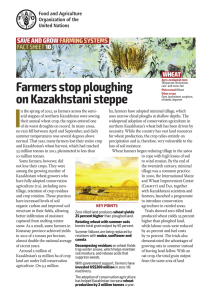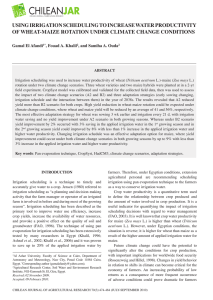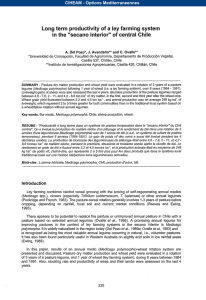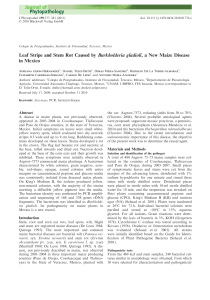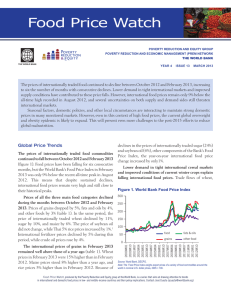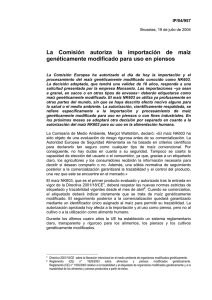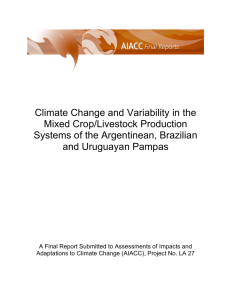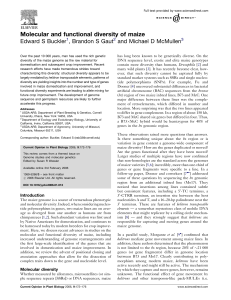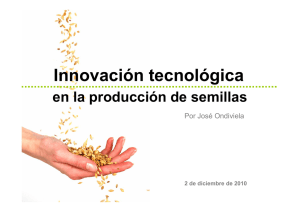Cereals in Argentina
Anuncio
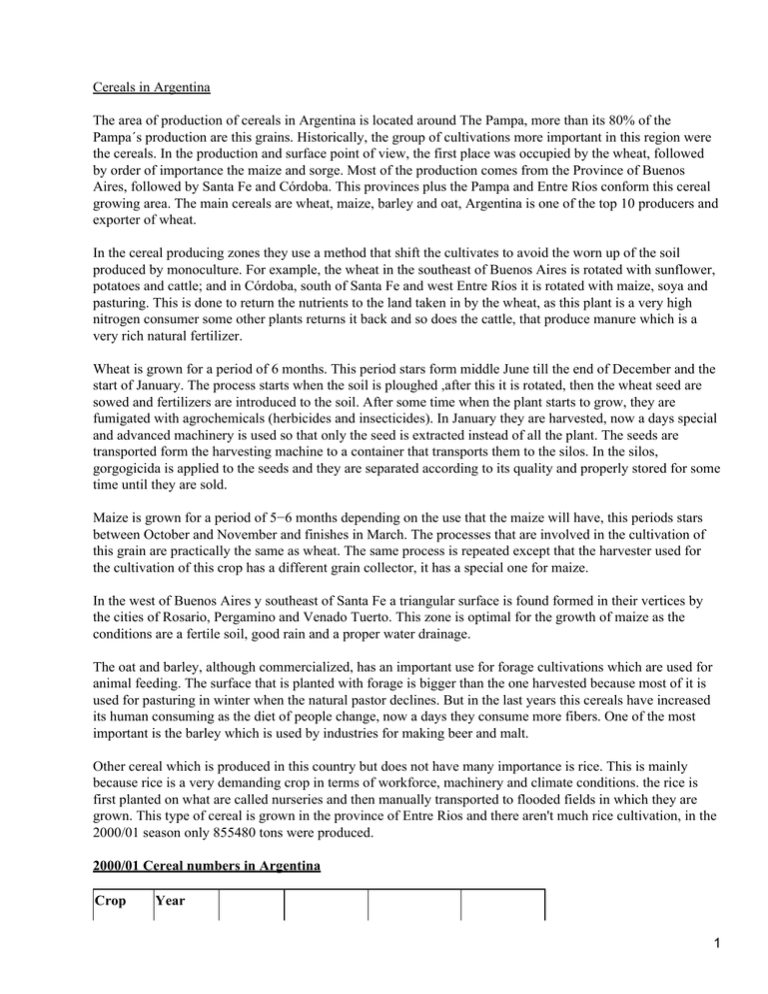
Cereals in Argentina The area of production of cereals in Argentina is located around The Pampa, more than its 80% of the Pampa´s production are this grains. Historically, the group of cultivations more important in this region were the cereals. In the production and surface point of view, the first place was occupied by the wheat, followed by order of importance the maize and sorge. Most of the production comes from the Province of Buenos Aires, followed by Santa Fe and Córdoba. This provinces plus the Pampa and Entre Ríos conform this cereal growing area. The main cereals are wheat, maize, barley and oat, Argentina is one of the top 10 producers and exporter of wheat. In the cereal producing zones they use a method that shift the cultivates to avoid the worn up of the soil produced by monoculture. For example, the wheat in the southeast of Buenos Aires is rotated with sunflower, potatoes and cattle; and in Córdoba, south of Santa Fe and west Entre Ríos it is rotated with maize, soya and pasturing. This is done to return the nutrients to the land taken in by the wheat, as this plant is a very high nitrogen consumer some other plants returns it back and so does the cattle, that produce manure which is a very rich natural fertilizer. Wheat is grown for a period of 6 months. This period stars form middle June till the end of December and the start of January. The process starts when the soil is ploughed ,after this it is rotated, then the wheat seed are sowed and fertilizers are introduced to the soil. After some time when the plant starts to grow, they are fumigated with agrochemicals (herbicides and insecticides). In January they are harvested, now a days special and advanced machinery is used so that only the seed is extracted instead of all the plant. The seeds are transported form the harvesting machine to a container that transports them to the silos. In the silos, gorgogicida is applied to the seeds and they are separated according to its quality and properly stored for some time until they are sold. Maize is grown for a period of 5−6 months depending on the use that the maize will have, this periods stars between October and November and finishes in March. The processes that are involved in the cultivation of this grain are practically the same as wheat. The same process is repeated except that the harvester used for the cultivation of this crop has a different grain collector, it has a special one for maize. In the west of Buenos Aires y southeast of Santa Fe a triangular surface is found formed in their vertices by the cities of Rosario, Pergamino and Venado Tuerto. This zone is optimal for the growth of maize as the conditions are a fertile soil, good rain and a proper water drainage. The oat and barley, although commercialized, has an important use for forage cultivations which are used for animal feeding. The surface that is planted with forage is bigger than the one harvested because most of it is used for pasturing in winter when the natural pastor declines. But in the last years this cereals have increased its human consuming as the diet of people change, now a days they consume more fibers. One of the most important is the barley which is used by industries for making beer and malt. Other cereal which is produced in this country but does not have many importance is rice. This is mainly because rice is a very demanding crop in terms of workforce, machinery and climate conditions. the rice is first planted on what are called nurseries and then manually transported to flooded fields in which they are grown. This type of cereal is grown in the province of Entre Rios and there aren't much rice cultivation, in the 2000/01 season only 855480 tons were produced. 2000/01 Cereal numbers in Argentina Crop Year 1 Wheat 2000/01 Crop Year Maize 2000/01 Crop Year Oat 2000/01 Planted (ha) 6496600 Planted (ha) 3497523 Planted (ha) 372550 Crop Year Beer Barley 2000/01 Harvested (ha) 6408045 Production (tn) 15959352 Harvested (ha) 2817524 Harvested (ha) 86850 Planted (ha) 246240 Production (tn) 61501 Production (tn) 125140 Harvested (ha) 245130 Yielding (kg/ha) 2490.5181 Yelding (kg/ha) 21.82803 Yelding (kg/ha) 1440.8751 Production (tn) 676060 Yelding (kg/ha) 2757.9651 The destination of this cereals are not only to be sold in Argentina, but much of it is exported and soled in the exterior. Argentina is a mayor grain exporter world widely, is one of the 10th world wheat exporter and the 3rd world Soya exporter. If we take a wheat example, up to the 7/4/02 there have been harvested 15.7 millions tones approximately, from which 6.5 have been exported up to now. The problems that farmers have to face now a days in the production of cereals are several and of many kinds. They can be divided into groups: the natural or physical factors and governmental or economic factors. The natural or physical factors include flooding, drought, inappropriate climate, erosion, pollution and pests. Every year there are worst floodings, longer droughts, weather is changing abruptly each year and those things aren't at all nice for the growing of these crops. The economic or governmental factors are several more. They include lack of technology and farming techniques, absence of infrastructure to carry o this activities, lack of demand in the market, excess taxes and lack of government facilities and agricultural plans.. Although in the recent years there have been a lot of improvements that made this processes easier and more efficient. The constant science advances make production greater and construct a very competitive atmosphere. Grains have been genetically modified to produce higher yielding, reduce their water consumption, accept a wider range of temperatures and several more advantages. There even is a type of seed that already include fertilizer, although they are more expensive in the long term they save money and facilitate things very much. More advanced machinery is being introduced to this farming processes too. Harvesters, tractors, etc, are now better, they consume less fuel, they take out the grain better and with every new model the harvesting time is reduced. 2 Analysis form the newspapers As we all now the Argentinean currency has been devaluated and this have several consequences on the agricultural business. The price of grain for export will be lower but the profits for farmers will be always the same, as the price is lower the demands are supposed to be greater. But instead of making advantage of this and letting the exports to flow easily and increase Argentina's wealth, the government has imposed a serious of retentions to the exports. This would make a lot of farmers loose their interest on exporting grains as the profit would not be as big as before. There are other problems such as the rises in prices of the transport, harvesting and fertilizers, which they all used to be brought from abroad the country. As our currency is devaluated it is more expensive to buy this products and machines, so the profit of the farmers are even less. But despite to this up to now the grain business is going pretty well, as a lot of grains have been sold to the exterior and Argentina is competing in the first places in the world grain market. wheat 3 maize 4
